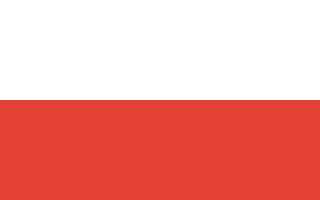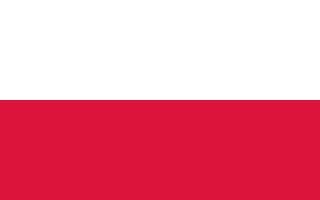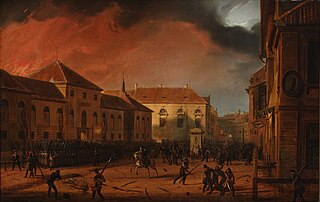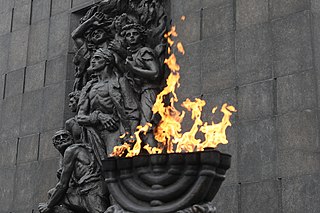
| Part of a series on |
| Liberalism in Poland |
|---|
 |
Wincenty Niemojowski (1784-1834) was a Polish political activist in Congress Poland. Member of the Kalisz Opposition, later joined the revolutionary government during the November Uprising.

| Part of a series on |
| Liberalism in Poland |
|---|
 |
Wincenty Niemojowski (1784-1834) was a Polish political activist in Congress Poland. Member of the Kalisz Opposition, later joined the revolutionary government during the November Uprising.

Gdańsk is a city on the Baltic coast of northern Poland, and the capital of the Pomeranian Voivodeship. With a population of 486,492, it is Poland's sixth-largest city and principal seaport. Gdańsk lies at the mouth of the Motława River and is situated at the southern edge of Gdańsk Bay, close to the city of Gdynia and resort town of Sopot; these form a metropolitan area called the Tricity (Trójmiasto), with a population of approximately 1.5 million.

The Second Polish Republic, at the time officially known as the Republic of Poland, was a country in Central and Eastern Europe that existed between 7 October 1918 and 6 October 1939. The state was established in the final stage of World War I. The Second Republic ceased to exist in 1939, after Poland was invaded by Nazi Germany, the Soviet Union, and the Slovak Republic, marking the beginning of the European theatre of the Second World War. The Polish government-in-exile was established in Paris and later London after the fall of France in 1940.

Poland, officially the Republic of Poland, is a country in Central Europe. It extends from the Baltic Sea in the north to the Sudetes and Carpathian Mountains in the south, and has a temperate transitional climate, while its longest river is the Vistula. Poland is the fifth-most populous member state of the European Union, with its sixteen voivodeships comprising a total population of over 38 million and covering a combined area of 312,696 km2 (120,733 sq mi). It is bordered by Lithuania and Russia to the northeast, Belarus and Ukraine to the east, Slovakia and the Czech Republic to the south, and Germany to the west. The nation's capital and largest metropolis is Warsaw. Other major cities include Kraków, Wrocław, Łódź, Poznań, and Gdańsk.

Kalisz is a city in central Poland, and the second-largest city in the Greater Poland Voivodeship, with 97,905 residents. It is the capital city of the Kalisz Region. Situated on the Prosna river in the southeastern part of Greater Poland, the city forms a conurbation with the nearby towns of Ostrów Wielkopolski and Nowe Skalmierzyce.

Polish people, or Poles, are a West Slavic ethnic group and nation who share a common history, culture, the Polish language and are identified with the country of Poland in Central Europe. The preamble to the Constitution of the Republic of Poland defines the Polish nation as comprising all the citizens of Poland, regardless of heritage or ethnicity. The majority of Poles adhere to Roman Catholicism.

The Invasion of Poland, also known as the September Campaign, Polish Campaign, War of Poland of 1939, and Polish Defensive War of 1939, was a joint attack on the Republic of Poland by Nazi Germany, the Slovak Republic, and the Soviet Union; which marked the beginning of World War II. The German invasion began on 1 September 1939, one week after the signing of the Molotov–Ribbentrop Pact between Germany and the Soviet Union, and one day after the Supreme Soviet of the Soviet Union had approved the pact. The Soviets invaded Poland on 17 September. The campaign ended on 6 October with Germany and the Soviet Union dividing and annexing the whole of Poland under the terms of the German–Soviet Frontier Treaty. The invasion is also known in Poland as the September campaign or 1939 defensive war and known in Germany as the Poland campaign.

Poland–Lithuania, formally known as the Kingdom of Poland and the Grand Duchy of Lithuania and also referred to as the Polish–Lithuanian Commonwealth or the First Polish Republic, was a bi-confederal state, sometimes called a federation, of Poland and Lithuania ruled by a common monarch in real union, who was both King of Poland and Grand Duke of Lithuania. It was one of the largest and most populous countries of 16th- to 17th-century Europe. At its largest territorial extent, in the early 17th century, the Commonwealth covered almost 1,000,000 km2 (400,000 sq mi) and as of 1618 sustained a multi-ethnic population of almost 12 million. Polish and Latin were the two co-official languages, and Catholicism served as the state religion.

The Polish People's Republic (1952–1989), formerly the Republic of Poland (1947–1952), was a country in Central Europe that existed from 1947 to 1989 as the predecessor of the modern-day democratic Republic of Poland. With a population of approximately 37.9 million near the end of its existence, it was the second most-populous communist and Eastern Bloc country in Europe, and one of the main signatories of the Warsaw Pact alliance. The largest city and official capital since 1947 was Warsaw, followed by the industrial city of Łódź and cultural city of Kraków. The country was bordered by the Baltic Sea to the north, the Soviet Union to the east, Czechoslovakia to the south, and East Germany to the west.

The November Uprising (1830–31), also known as the Polish–Russian War 1830–31 or the Cadet Revolution, was an armed rebellion in the heartland of partitioned Poland against the Russian Empire. The uprising began on 29 November 1830 in Warsaw when young Polish officers from the military academy of the Army of Congress Poland revolted, led by Lieutenant Piotr Wysocki. Large segments of the peoples of Lithuania, Belarus, and Right-bank Ukraine soon joined the uprising. Although the insurgents achieved local successes, a numerically superior Imperial Russian Army under Ivan Paskevich eventually crushed the uprising. The Russian Emperor Nicholas I issued the Organic Statute in 1832, according to which, henceforth Russian-occupied Poland would lose its autonomy and become an integral part of the Russian Empire. Warsaw became little more than a military garrison, and its university closed.

The history of the Jews in Poland dates back at least 1,000 years. For centuries, Poland was home to the largest and most significant Ashkenazi Jewish community in the world. Poland was a principal center of Jewish culture, because of the long period of statutory religious tolerance and social autonomy which ended after the Partitions of Poland in the 18th century. During World War II there was a nearly complete genocidal destruction of the Polish Jewish community by Nazi Germany and its collaborators of various nationalities, during the German occupation of Poland between 1939 and 1945, called the Holocaust. Since the fall of communism in Poland, there has been a renewed interest in Jewish culture, featuring an annual Jewish Culture Festival, new study programs at Polish secondary schools and universities, and the opening of Warsaw's Museum of the History of Polish Jews.

The Kingdom of Poland, also known informally as the Regency Kingdom of Poland, was a short-lived polity that was proclaimed during World War I by the German Empire and Austria-Hungary on 5 November 1916 on the territories of formerly Russian-ruled Congress Poland held by the Central Powers as the Government General of Warsaw and which became active on 14 January 1917. It was subsequently transformed between 7 October 1918 and 22 November 1918 into the independent Second Polish Republic, the customary ceremonial founding date of the latter being later set at 11 November 1918.

The Poland national football team represents Poland in men's international football competitions since their first match in 1921. They are known by the nicknames "The White-Reds" and "The Eagles", symbolized by their coat of arms featuring a white eagle on a red background.

Konstantin Pavlovich was a grand duke of Russia and the second son of Emperor Paul I and Sophie Dorothea of Württemberg. He was the heir-presumptive for most of his elder brother Alexander I's reign, but had secretly renounced his claim to the throne in 1823. For 25 days after the death of Alexander I, from 19 November (O.S.)/1 December 1825 to 14 December (O.S.)/26 December 1825 he was known as His Imperial Majesty Konstantin I Emperor and Sovereign of Russia, although he never reigned and never acceded to the throne. His younger brother Nicholas became tsar in 1825. The succession controversy became the pretext of the Decembrist revolt.

Vanves is a commune in the southwestern suburbs of Paris, France. It is located 5.6 km (3.5 mi) from the centre of Paris. It is one of the most densely populated municipalities in Europe and the tenth in France

Polish National Government of 1831 was a Polish supreme authority during the November Uprising against the Russian occupation of the Polish–Lithuanian Commonwealth. It was formed by the decree of the Sejm (parliament) of the Congress Poland on 29 January 1831 to assume the competences of the Polish head of state in the follow-up of an earlier decree of 25 January: deposing the usurping Tsar Nicholas I of Russia from the throne of Poland.

Marchwacz is a village in the administrative district of Gmina Szczytniki, within Kalisz County, Greater Poland Voivodeship, in central Poland. It lies approximately 16 kilometres (10 mi) east of Kalisz and 121 km (75 mi) south-east of the regional capital Poznań.

The Provisional Council of State was the first government of the Kingdom of Poland, a new state created by the military authorities of Germany and Austria on some Polish lands during the First World War.
The Sejm of Congress Poland was the parliament in the 19th century Kingdom of Poland, colloquially known as Congress Poland. It existed from 1815 to 1831. In the history of the Polish parliament, it succeeded the Sejm of the Duchy of Warsaw.
Liberalism has been a notable ideology in Poland for hundreds of years. Polish liberalism emphasizes the preservation of democracy and opposition to authoritarianism. Liberalism was first developed in Poland as a response to the Polish–Lithuanian monarchy, and it continued to develop in response to the partition of Poland through the 19th century and Communist rule in the 20th century. Poland has officially been a liberal democracy since 1989, though its status has challenged as a result of illiberal reforms in the 2010s and 2020s.